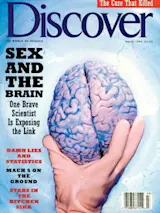You might say that Simon LeVay rose to fame though a venerable locker-room tradition: sizing up the sexual anatomy of males. In his case, though, the body part in question was a speck in the brain's spongy underbelly--to be precise, a tiny cell cluster known as the third interstitial nucleus of the anterior hypothalamus, or INAH3. "There's strong evidence," notes LeVay, "that this part of the hypothalamus is deeply involved in regulating male-typical sex behavior."
Two and a half years ago LeVay, then a neurobiologist at the Salk Institute in La Jolla, California, caused a sensation by reporting a minute but measurable difference in this brain area between homosexual and heterosexual men. You could almost hear millions of nervous guys breathe a sigh of relief: yes, on average, INAH3 is bigger in straight men than in gay men (though at its most virile, the tiny nucleus wouldn't even fill the ...














